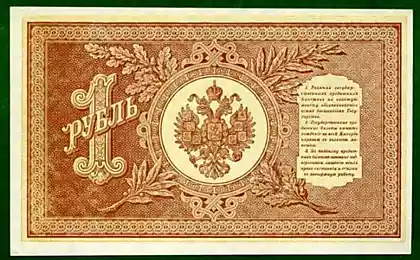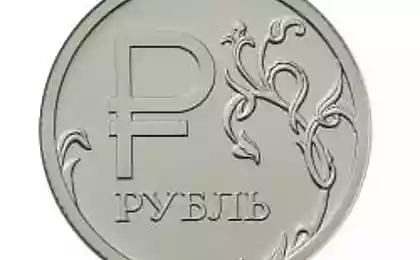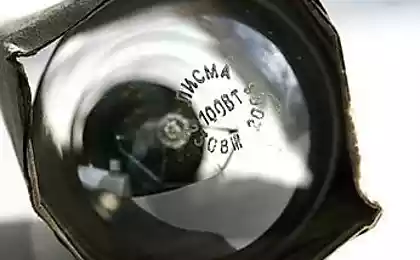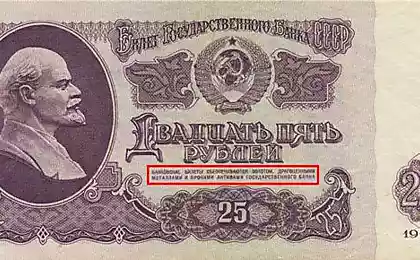1692
The history of the ruble
Occurrence name
Ruble - Part silver ingot, who bore the name "hryvnia." These ingots were walking in ancient Russia as a means of exchange. The price of goods is expressed in hryvnia, just like in ancient times, it is calculated in talents. Cash bullion ordered a special foundry (in the Old Russian "livtsam"). Master cast a bar spoon in a special form, which corresponds to the weight capacity of the hryvnia. Spill hryvnia as much material was prepared from the customer returned the remains Liwiec "until the next redistribution." All Russian livtsy after the invasion of the Mongols lived in Novgorod. They were without exception, no one except them, bullion did. Therefore, if the ingot was no trace of the cut, it is accepted for payment without checking the sample. Marks and stamps on the hryvnia was not.
Silver was the most compact form of wealth. It was easier to bring along, or buried in the ground, without fear that it will deteriorate. After the Mongol invasion sellers increasingly prefer to receive for their goods silver. But not all have the goods on the hryvnia. Say, the calf was worth a hundred times smaller. Looking for silver bars were smaller. Hryvnia began to cut into two parts, and it turned into a ruble (what cut). Some historians believe this explanation is too simple. They produce the word ruble from the rumen - a seam on the ingot.
The ruble was divided into two parts with a chisel. Each part is called a half rubles. To cut to the silver does not chop off poltinas, it was applied to the stigma. Such rubles and poltinas there in the Hermitage.
As the counting unit ruble mentioned at the end of the XIII century in Novgorod birch bark. For example, in the will moneylender between 1300 and 1320 years. (Diploma №138): «Here I am, the servant of God Selivestrov, wrote his will. In Lunkov poltina. In Zechariah poltina. Children Alyuya poltina. Children Kuzma Onisimova two hryvnia. Semyon Yakovlev two chains at the cost of two rubles with a cross and armor at the cost of two [hryvnia] of silver. "[6]
According to the researchers birch-bark scrolls, before the ruble counting unit it was hryvnia silver ingot weighing about 196 grams. 1 UAH = 4 silver hryvnia kun Nogat = 80 = 200 = 600 Rezan veverits.
In Novgorod the XV century became the main unit of a silver ruble, weighing about 170 grams. 1 Rouble = 216 money, 1 hryvnia = 14 7 = money white, 15 = 210 hryvnia money. During the ruble could buy a good horse.
Denga- "tit" Ivan the Terrible. Silver, a diameter of about 10 mm
On one side of the free money is the name of the king, on the other horseman with a sword.
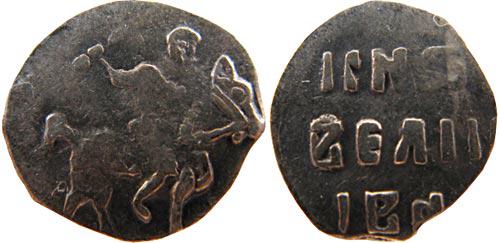
When Dmitry Donskoy in the Moscow principality, and later in other Russian lands began minting its own coins. Silver ingot pulled in the wire that cuts it into equal pieces of the desired weight. Then these pieces of ivy and silver oval plate went into business. They put on a stamp, covered with another stamp and beat it with a hammer manually. Thus the top on one side of the coin is not obtained, where on the other side. In this respect, the technology was more backward than ancient Rome. Coins were called "money" from the XIV century, the ruble was divided into 200 money. Hence the name of the coin polkopeyki - money.
In 1534 the boyars who ruled the country for minor Ivan the Terrible, spent the first monetary reform. In Moscow, Pskov and Novgorod began to mint a new, unified for the entire state coin twice as heavy as dengue. In the image of a rider with a spear, it was called "penny". The coin of the denomination already minted in Novgorod earlier, and until the time of Peter I wore the nickname "Novgorodka" as opposed denge- "tit". During the XVI-XVII centuries the ruble was 100 cents, but not minted, ie the unit of account remained
Silver penny of Boris Godunov. Silver, a diameter of about 15 mm. The name penny received by the image of a rider with a spear.
It is such a lot of money taken from the holy fool Nikolka evil boys in drama AS Pushkin's "Boris Godunov." On the penny could buy a live chicken or a peck of cucumbers.

When Dmitry Donskoy in the Moscow principality, and later in other Russian lands began minting its own coins. Silver ingot pulled in the wire that cuts it into equal pieces of the desired weight. Then these pieces of ivy and silver oval plate went into business. They put on a stamp, covered with another stamp and beat it with a hammer manually. Thus the top on one side of the coin is not obtained, where on the other side. In this respect, the technology was more backward than ancient Rome. Coins were called "money" from the XIV century, the ruble was divided into 200 money. Hence the name of the coin polkopeyki - money.
In 1534 the boyars who ruled the country for minor Ivan the Terrible, spent the first monetary reform. In Moscow, Pskov and Novgorod began to mint a new, unified for the entire state coin twice as heavy as dengue. In the image of a rider with a spear, it was called "penny". The coin of the denomination already minted in Novgorod earlier, and until the time of Peter I wore the nickname "Novgorodka" as opposed denge- "tit". During the XVI-XVII centuries the ruble was 100 cents, but not minted, ie remained the counting unit.
Chasing Moscow penny. Russian portrait miniature of the XVI century.

The appearance of the metal ruble
The kings of the Romanov dynasty minted gold, wore the name "gold coins". The first silver ruble came under Tsar Alexei Mikhailovich in 1654. The issue was small. It was an analogue of the European taler, its actual value is equal to 64 kopecks.
It is technically easier to import from Europe thalers and release into circulation with countermark. These coins were called "efimki to sign." This Russian ruble came under Peter I in 1704. Fractional coins - free money, penny farthing (face value of half of dengue) - steel copper. Coinage reforms on the European model and Gurtovoiy notch Peter began in 1698 on his return from the Great Embassy. For two hundred years, the coins were issued following denominations:
Copper coins
-polpolushki, eighth of a penny (1700)
-¼ Dime mite (1700-1916)
-½ Penny, money, money (1700-1916). Nickname: penny (in the XIX century)
-1 Penny (1704-1916) Nickname: trynka (in Siberia), sorokivka (Ukraine)
-2 Penny penny (1724-1916). Nicknames: Semitko, semishnik, Semak
-3 Penny (1827-1916). Nicknames: Altyn, trynka, Treshnikov, UAH
-4 Penny (1762 and 1796)
-5 Cents (1723-1916). Nicknames: penny, penny
-10 Cents, a dime (1726-1839)
-grivna - square copper plates weighing 163, 8 g (1726 Ekaterinburg)
-polpoltiny - square copper plates weight 409, 51 g (1725-1726, Ekaterinburg)
-poltina - square copper plates weight 819, 03 g (1726 Ekaterinburg)
-rubl - square copper plates weighing 1638 g of 05 (1725-1726, Ekaterinburg)
Kopeck 1762. Copper. Diameter 20, 5 mm, weight 5, '12

Silver coins
-1 Penny (1713-1730)
-grosh (2 penny, only in 1727)
-3 Penny, Altyn, altynnik (1704-1727)
-5 Cents ((1701-1917), silver penny, ten money)
-10 Cents (1701-1917). Nickname: dime
-15 Cents (1760-1917). Nickname: fifteen kopecks
-20 Cents (1760-1917). Nickname: twenty kopecks
-25 Cents (1701-1901). Nickname: quarter, polupoltina
-50 Cents (1699-1914). Nickname and denomination in the XVIII-XIX centuries: poltina, fifty dollars
-1 Ruble (1704-1915). Nicknames: ruble, tselkovik, coin, coins
-Efimok (1798, slightly higher than the value of the ruble)
Silver rubles in 1833. Sample 868/1000, diameter 35 mm, weight 20, '73

Gold coins
-1 Ruble (1756-1758)
-chervonets (cost approximately 1, 5 rubles, 1701-1797)
-2 Ruble (1718-1728)
-double ducat (cost about 3 rubles, 1701-1751)
-3 Ruble (1869-1885)
-5 Rubles (poluimperial, 1755-1911)
-7½ Rubles (poluimperial sample 1897)
-10 Rubles (imperial, 1755-1911)
-15 Rubles (imperial sample 1897)
-20 Rubles (1755)
-25 Rubles, 2½ imperial (1908)
Platinum coins
-3 Ruble (1828-1845)
-6 Rubles (1829-1845)
-12 Rubles (1830-1845)
5 rubles 1899. Gold. Sample 900/1000, diameter 18, 5 mm, weight 4, 3 years

Russian paper money
Russian-Turkish war of 1768-1774. entailed such costs, that the results of 1768 state budget deficit amounted to 1 million 800 thousand. rub. To cover the deficit, it was decided to issue paper money - banknotes.
The idea belonged to Marshal Count Carl Sievers. He was presented in 1753 breech Krasnoselskaya Manufactory in St. Petersburg, built by order of Peter I in 1716. It supplies and postage stamp paper with water marks. Sievers was interested in expanding production and persuaded his nephew, the governor-general of Novgorod, Tver and Pskov Jacob Sievers submit a note to Catherine II with plans to introduce bills. Prior to the establishment of official Department of State securities (abbreviated EZGB now Gosznak) in 1818 banknotes were printed on paper manufactured factory owned by private individuals.
December 29, 1768 (New Style January 10, 1769) Catherine II issued a manifesto on the release of the paper money in the amount of 1 million rubles. in denominations of 25, 50, 75 and 100 rubles. For their issue establishes state Assignation Bank (hereinafter after numerous transformations and renaming - State Bank, State Bank). In the back of the banknotes were on 3 February (new style February 14), 1769.
They were initially provided with a copper coin, but soon devalued. In 1796, for 1 ruble banknotes were given 79 kopeks. silver., in 1812 - 25, 2 kopeks., 25 in 1817, 17 kopecks. After that, the government stopped the growth of the number of banknotes. In 1824-1839 gg. silver ruble exchange rate was around 350-370 cop. At that time there was a well-known Russian literature on the difference between the "silver rubles" and "paper rubles».
The largest cuts were Russian state credit notes in denominations of 500 rubles. Dimensions 275h126 mm, the front of the gray-salad turnover multicolor. Paper hemp. Backside made Orel printing in a single pass. [7] Invented in 1891 in EZGB way to print colorful transitions used for the protection of modern Russian and foreign banknotes.
In 1839-1844 banknotes replaced the banknotes (in use credit cards), provision of specie. Their colors have become a tradition, which to some extent the creators of design banknotes followed until now. The colors and images of banknotes they have created nicknames, recorded in Russian literature:
1 ruble - ticket, yellowish, canary
3 BR - Greenfinch
5 rubles - sinenkaja, cyanosis, titmouse
10 rubles - reds, rubella, cancer
25 rubles - fair, quarter-angle
50 rubles - no nicknames
$ 100 - the state, rainbow, Katerinka, Katya, Katya (the image of Catherine II)
500 rubles - Petrovka (the image of Peter I)
Denomination banknotes of 25 rubles times of Catherine II, 1778
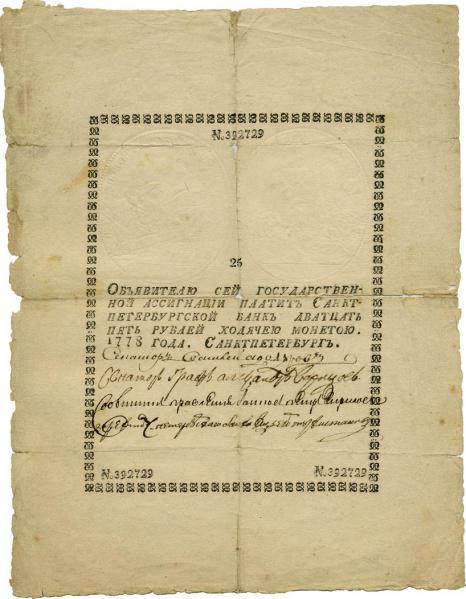
The purchasing power of the pre-revolutionary rubles (The Moscow newspaper in 1911)
Annual salary (the so-called officer's salary or allowance) Muscovites in 1911:
Civil servants: senior officials of grade 8, investigators, inspectors - from 3000 to 4000 p. The salaries of civil servants were issued normally every 20th day. Employee acquired and repaired his uniform at his own expense.
Intellectuals (accountants, paramedics, engineers, and journalists), 1000 - 1500 p.
Officers 800 - 2000 p. (the amount issued by third - once every 4 months) uniform, equipment and personal weapons officer bought at his own expense, so that the money he was less than that of the worker. Razed to the intelligentsia could captains received 1,000 rubles, and higher ranks.
Teachers and educators, "senior uchaschie" - 660 p. and an apartment with heating and lighting, "cool uchaschie" - 460 p. salaries and 240 p. apartment.
Policemen - 200 p. the provision of family housing in the barracks.
Working rare specialties (eg electricians) - 700 p.
The average worker - 285 p., Worker - 200 p.
For most Muscovites budget 1 ruble a day - dream.
The largest cuts were Russian state credit notes in denominations of 500 rubles. Dimensions 275h126 mm, the front of the gray-salad turnover multicolor. Paper hemp. Backside made Orel printing in a single pass. [7] Invented in 1891 in EZGB way to print colorful transitions used for the protection of modern Russian and foreign banknotes.
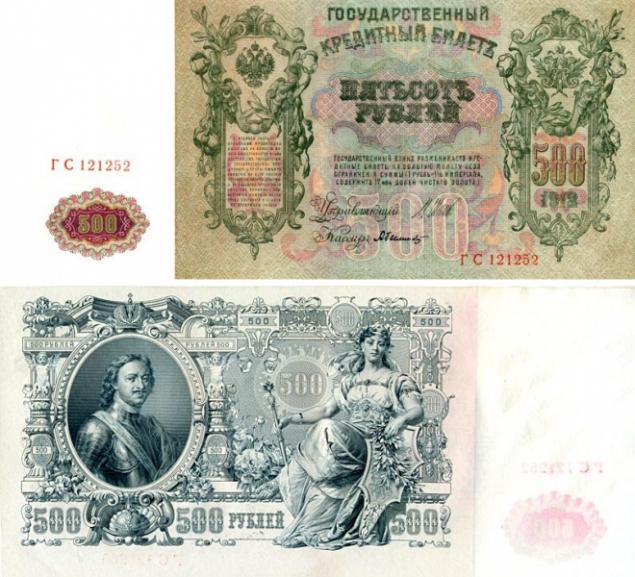
Prices 1911
- Directions: In a cab - 15 cents on average over half of the city, in remote areas like the Lefortovo or three-station - 30 kopecks, with luggage - 40. Job cab was not very profitable: the day the horse would eat at 3 rubles oats. The tram - 5 cents before the end of the route, if necessary transplant issued free transfer ticket. Travel around the Garden Ring (B) cost 7 cents. Students were free tickets with photos so that they could not transfer them to others. On Likhachev (high-speed cab with good horses) or taxis - up to 1 p.
- Miscellaneous goods and services:
- Women's Shoes black leather - 3 p. 50 in., Color of skin - expensive at 1 p.
- Cheap cigarettes - from 10 to 20 pieces of 6 to.
- Electricity - 25 in. Per 1 kW • h.
- Telegram from Moscow in one tariff zone (St. Petersburg) - 62 in. For the message of 25 words or less.
- Water supply - home to 12. Per bucket, a water carrier from 13 to. In the dishes by hand column - free of charge.
- Take a steam bath - from 5 to. (Vulgar) to 30 k., Luxury bath with separate rooms like Sandune - 1 p. and more.
- Home phone - 79 p. per month.
- Year of the child's activities at school - from 150 to 300 rubles.
- Food:
- Couple grechnevikov (hot buckwheat pancakes with butter and salt) or ice cream on the street - 1 cop. The workers ate in the so-called "Pyrkov" - cheap inns Obzhornogo series (part Okhotny). For 3 to. It was possible to eat a bowl of soup, 5 k. - Noodles on hemp oil, or fried potatoes. Drink tea with two lumps of sugar in the "folksy tavern" worth 5 in., The three of us - 10 in., A shot of vodka - to 10-20. Lunch intelligent person in the cafeteria of the People's House - 15 in., In the student dining room - 25-30 . (the cheapest food - a plate of borscht - 3 k.) in top of table - 55 in. Pancakes with fresh caviar and vodka in the pub (to dump) - 1 p. Three-course dinner with live music in the restaurant "Slavic Bazaar" - 1 p. 75 a.
- Pound of tea in the store Botkin - 2 p. 40 kopecks.
- Pound quality flour - 6 kopecks.
- Kalach in a bakery - 2, 5 kopecks.
- French bread (a loaf of bread) - 5 kopecks.
- Pound of butter - 55 kopecks.
- Eggs are small, a dozen - 44 kopecks.
- Dutch Herring, a dozen - to 40 kopecks.
- Pound Swedish salmon - 90 kopecks.
- The pound Siberian salmon (red) caviar - 40-75 kopecks.
- A bottle of "monopoly" vodka "Moscow special" - 17, 5 kopecks.
- Housing: The biggest problem:
- The bed in the hospital bed-kamorochnom workers' hostel - 2 p. per month, cubby - 5-6 p. per month; 3 remove a tiny room with no kitchen facilities worth 40-50 p. per month;
- Apartment 4-5 rooms with bath and electricity - 100 p. per month.
- Room in a cheap hotel - 20 p. per month, furnished rooms - 75 k. a day.
- Hotel room class "Imperial" with living room, bathroom and bedroom - 10 p. per day.
Entertainment:
- Tickets for the concert of pop stars on a national scale (eg Plevitskaya) - from 1 to 10 p.
- Subscribe to the Small Hall of the Conservatory of Music for 3 nights with a good performer on 2r.40k. to 7r.30k.
- Trotter (own horse) without content - 1000 r. Reward for missing dog - 25 p.
Compulsory payments:
- The amount of collateral that brought people to go to work the cashier, manager, clerk - 500 p. Artel'nyi share - from 100 rubles. (leaving the farm, the worker sold his share). Went to work at the hotel, any employee bail by firing, getting it back. Pawn, under which released from custody during the investigation - from 2000 p. The penalty, which can be bought off by the administrative detention for 15 days - 50 p. Small bribes to officials to expedite paperwork - 5-10 p.
- Bribe police to avoid driving to the station - 3 p. ("Venerable serviceman accept greenbacks»).
Silver ruble minted to celebrate the 300th anniversary of the reign of the Romanov dynasty. Sample 900/1000, diameter 33, 5 mm, weight 20 g
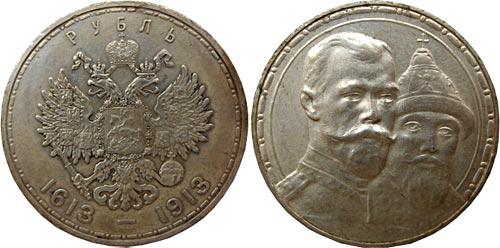
The ruble during the revolution and civil war
With the start of World War I, the State Bank stopped the exchange of banknotes on a coin. As a subject, who had a material value, coins gradually disappeared, having settled in the egg capsules of the population. Since 1916, a steep rise in prices, and the main means of payment for several years have been banknotes.
The interim government has issued the first money of the Russian Republic May 9 (April 26 Old Style), 1917. It was the denominations of 250 and 1,000 rubles (with a picture of the building of the State Duma - the Tauride Palace; because of this credit Provisional Government called "Duma money" ). On the advantage of 250 rubles a ticket. depicted in the background of the swastika emblem of the new Russia - the two-headed eagle with outstretched wings without a crown, orb and scepter.
The cost of financing the war grew, and the government headed by Kerensky AF Kerensky, September 5 (August 23 Old Style) issued a decree on the issue of Treasury signs advantage of 20 and 40 rubles.
All.
Source:
Ruble - Part silver ingot, who bore the name "hryvnia." These ingots were walking in ancient Russia as a means of exchange. The price of goods is expressed in hryvnia, just like in ancient times, it is calculated in talents. Cash bullion ordered a special foundry (in the Old Russian "livtsam"). Master cast a bar spoon in a special form, which corresponds to the weight capacity of the hryvnia. Spill hryvnia as much material was prepared from the customer returned the remains Liwiec "until the next redistribution." All Russian livtsy after the invasion of the Mongols lived in Novgorod. They were without exception, no one except them, bullion did. Therefore, if the ingot was no trace of the cut, it is accepted for payment without checking the sample. Marks and stamps on the hryvnia was not.
Silver was the most compact form of wealth. It was easier to bring along, or buried in the ground, without fear that it will deteriorate. After the Mongol invasion sellers increasingly prefer to receive for their goods silver. But not all have the goods on the hryvnia. Say, the calf was worth a hundred times smaller. Looking for silver bars were smaller. Hryvnia began to cut into two parts, and it turned into a ruble (what cut). Some historians believe this explanation is too simple. They produce the word ruble from the rumen - a seam on the ingot.
The ruble was divided into two parts with a chisel. Each part is called a half rubles. To cut to the silver does not chop off poltinas, it was applied to the stigma. Such rubles and poltinas there in the Hermitage.
As the counting unit ruble mentioned at the end of the XIII century in Novgorod birch bark. For example, in the will moneylender between 1300 and 1320 years. (Diploma №138): «Here I am, the servant of God Selivestrov, wrote his will. In Lunkov poltina. In Zechariah poltina. Children Alyuya poltina. Children Kuzma Onisimova two hryvnia. Semyon Yakovlev two chains at the cost of two rubles with a cross and armor at the cost of two [hryvnia] of silver. "[6]
According to the researchers birch-bark scrolls, before the ruble counting unit it was hryvnia silver ingot weighing about 196 grams. 1 UAH = 4 silver hryvnia kun Nogat = 80 = 200 = 600 Rezan veverits.
In Novgorod the XV century became the main unit of a silver ruble, weighing about 170 grams. 1 Rouble = 216 money, 1 hryvnia = 14 7 = money white, 15 = 210 hryvnia money. During the ruble could buy a good horse.
Denga- "tit" Ivan the Terrible. Silver, a diameter of about 10 mm
On one side of the free money is the name of the king, on the other horseman with a sword.

When Dmitry Donskoy in the Moscow principality, and later in other Russian lands began minting its own coins. Silver ingot pulled in the wire that cuts it into equal pieces of the desired weight. Then these pieces of ivy and silver oval plate went into business. They put on a stamp, covered with another stamp and beat it with a hammer manually. Thus the top on one side of the coin is not obtained, where on the other side. In this respect, the technology was more backward than ancient Rome. Coins were called "money" from the XIV century, the ruble was divided into 200 money. Hence the name of the coin polkopeyki - money.
In 1534 the boyars who ruled the country for minor Ivan the Terrible, spent the first monetary reform. In Moscow, Pskov and Novgorod began to mint a new, unified for the entire state coin twice as heavy as dengue. In the image of a rider with a spear, it was called "penny". The coin of the denomination already minted in Novgorod earlier, and until the time of Peter I wore the nickname "Novgorodka" as opposed denge- "tit". During the XVI-XVII centuries the ruble was 100 cents, but not minted, ie the unit of account remained
Silver penny of Boris Godunov. Silver, a diameter of about 15 mm. The name penny received by the image of a rider with a spear.
It is such a lot of money taken from the holy fool Nikolka evil boys in drama AS Pushkin's "Boris Godunov." On the penny could buy a live chicken or a peck of cucumbers.

When Dmitry Donskoy in the Moscow principality, and later in other Russian lands began minting its own coins. Silver ingot pulled in the wire that cuts it into equal pieces of the desired weight. Then these pieces of ivy and silver oval plate went into business. They put on a stamp, covered with another stamp and beat it with a hammer manually. Thus the top on one side of the coin is not obtained, where on the other side. In this respect, the technology was more backward than ancient Rome. Coins were called "money" from the XIV century, the ruble was divided into 200 money. Hence the name of the coin polkopeyki - money.
In 1534 the boyars who ruled the country for minor Ivan the Terrible, spent the first monetary reform. In Moscow, Pskov and Novgorod began to mint a new, unified for the entire state coin twice as heavy as dengue. In the image of a rider with a spear, it was called "penny". The coin of the denomination already minted in Novgorod earlier, and until the time of Peter I wore the nickname "Novgorodka" as opposed denge- "tit". During the XVI-XVII centuries the ruble was 100 cents, but not minted, ie remained the counting unit.
Chasing Moscow penny. Russian portrait miniature of the XVI century.

The appearance of the metal ruble
The kings of the Romanov dynasty minted gold, wore the name "gold coins". The first silver ruble came under Tsar Alexei Mikhailovich in 1654. The issue was small. It was an analogue of the European taler, its actual value is equal to 64 kopecks.
It is technically easier to import from Europe thalers and release into circulation with countermark. These coins were called "efimki to sign." This Russian ruble came under Peter I in 1704. Fractional coins - free money, penny farthing (face value of half of dengue) - steel copper. Coinage reforms on the European model and Gurtovoiy notch Peter began in 1698 on his return from the Great Embassy. For two hundred years, the coins were issued following denominations:
Copper coins
-polpolushki, eighth of a penny (1700)
-¼ Dime mite (1700-1916)
-½ Penny, money, money (1700-1916). Nickname: penny (in the XIX century)
-1 Penny (1704-1916) Nickname: trynka (in Siberia), sorokivka (Ukraine)
-2 Penny penny (1724-1916). Nicknames: Semitko, semishnik, Semak
-3 Penny (1827-1916). Nicknames: Altyn, trynka, Treshnikov, UAH
-4 Penny (1762 and 1796)
-5 Cents (1723-1916). Nicknames: penny, penny
-10 Cents, a dime (1726-1839)
-grivna - square copper plates weighing 163, 8 g (1726 Ekaterinburg)
-polpoltiny - square copper plates weight 409, 51 g (1725-1726, Ekaterinburg)
-poltina - square copper plates weight 819, 03 g (1726 Ekaterinburg)
-rubl - square copper plates weighing 1638 g of 05 (1725-1726, Ekaterinburg)
Kopeck 1762. Copper. Diameter 20, 5 mm, weight 5, '12

Silver coins
-1 Penny (1713-1730)
-grosh (2 penny, only in 1727)
-3 Penny, Altyn, altynnik (1704-1727)
-5 Cents ((1701-1917), silver penny, ten money)
-10 Cents (1701-1917). Nickname: dime
-15 Cents (1760-1917). Nickname: fifteen kopecks
-20 Cents (1760-1917). Nickname: twenty kopecks
-25 Cents (1701-1901). Nickname: quarter, polupoltina
-50 Cents (1699-1914). Nickname and denomination in the XVIII-XIX centuries: poltina, fifty dollars
-1 Ruble (1704-1915). Nicknames: ruble, tselkovik, coin, coins
-Efimok (1798, slightly higher than the value of the ruble)
Silver rubles in 1833. Sample 868/1000, diameter 35 mm, weight 20, '73

Gold coins
-1 Ruble (1756-1758)
-chervonets (cost approximately 1, 5 rubles, 1701-1797)
-2 Ruble (1718-1728)
-double ducat (cost about 3 rubles, 1701-1751)
-3 Ruble (1869-1885)
-5 Rubles (poluimperial, 1755-1911)
-7½ Rubles (poluimperial sample 1897)
-10 Rubles (imperial, 1755-1911)
-15 Rubles (imperial sample 1897)
-20 Rubles (1755)
-25 Rubles, 2½ imperial (1908)
Platinum coins
-3 Ruble (1828-1845)
-6 Rubles (1829-1845)
-12 Rubles (1830-1845)
5 rubles 1899. Gold. Sample 900/1000, diameter 18, 5 mm, weight 4, 3 years

Russian paper money
Russian-Turkish war of 1768-1774. entailed such costs, that the results of 1768 state budget deficit amounted to 1 million 800 thousand. rub. To cover the deficit, it was decided to issue paper money - banknotes.
The idea belonged to Marshal Count Carl Sievers. He was presented in 1753 breech Krasnoselskaya Manufactory in St. Petersburg, built by order of Peter I in 1716. It supplies and postage stamp paper with water marks. Sievers was interested in expanding production and persuaded his nephew, the governor-general of Novgorod, Tver and Pskov Jacob Sievers submit a note to Catherine II with plans to introduce bills. Prior to the establishment of official Department of State securities (abbreviated EZGB now Gosznak) in 1818 banknotes were printed on paper manufactured factory owned by private individuals.
December 29, 1768 (New Style January 10, 1769) Catherine II issued a manifesto on the release of the paper money in the amount of 1 million rubles. in denominations of 25, 50, 75 and 100 rubles. For their issue establishes state Assignation Bank (hereinafter after numerous transformations and renaming - State Bank, State Bank). In the back of the banknotes were on 3 February (new style February 14), 1769.
They were initially provided with a copper coin, but soon devalued. In 1796, for 1 ruble banknotes were given 79 kopeks. silver., in 1812 - 25, 2 kopeks., 25 in 1817, 17 kopecks. After that, the government stopped the growth of the number of banknotes. In 1824-1839 gg. silver ruble exchange rate was around 350-370 cop. At that time there was a well-known Russian literature on the difference between the "silver rubles" and "paper rubles».
The largest cuts were Russian state credit notes in denominations of 500 rubles. Dimensions 275h126 mm, the front of the gray-salad turnover multicolor. Paper hemp. Backside made Orel printing in a single pass. [7] Invented in 1891 in EZGB way to print colorful transitions used for the protection of modern Russian and foreign banknotes.
In 1839-1844 banknotes replaced the banknotes (in use credit cards), provision of specie. Their colors have become a tradition, which to some extent the creators of design banknotes followed until now. The colors and images of banknotes they have created nicknames, recorded in Russian literature:
1 ruble - ticket, yellowish, canary
3 BR - Greenfinch
5 rubles - sinenkaja, cyanosis, titmouse
10 rubles - reds, rubella, cancer
25 rubles - fair, quarter-angle
50 rubles - no nicknames
$ 100 - the state, rainbow, Katerinka, Katya, Katya (the image of Catherine II)
500 rubles - Petrovka (the image of Peter I)
Denomination banknotes of 25 rubles times of Catherine II, 1778

The purchasing power of the pre-revolutionary rubles (The Moscow newspaper in 1911)
Annual salary (the so-called officer's salary or allowance) Muscovites in 1911:
Civil servants: senior officials of grade 8, investigators, inspectors - from 3000 to 4000 p. The salaries of civil servants were issued normally every 20th day. Employee acquired and repaired his uniform at his own expense.
Intellectuals (accountants, paramedics, engineers, and journalists), 1000 - 1500 p.
Officers 800 - 2000 p. (the amount issued by third - once every 4 months) uniform, equipment and personal weapons officer bought at his own expense, so that the money he was less than that of the worker. Razed to the intelligentsia could captains received 1,000 rubles, and higher ranks.
Teachers and educators, "senior uchaschie" - 660 p. and an apartment with heating and lighting, "cool uchaschie" - 460 p. salaries and 240 p. apartment.
Policemen - 200 p. the provision of family housing in the barracks.
Working rare specialties (eg electricians) - 700 p.
The average worker - 285 p., Worker - 200 p.
For most Muscovites budget 1 ruble a day - dream.
The largest cuts were Russian state credit notes in denominations of 500 rubles. Dimensions 275h126 mm, the front of the gray-salad turnover multicolor. Paper hemp. Backside made Orel printing in a single pass. [7] Invented in 1891 in EZGB way to print colorful transitions used for the protection of modern Russian and foreign banknotes.

Prices 1911
- Directions: In a cab - 15 cents on average over half of the city, in remote areas like the Lefortovo or three-station - 30 kopecks, with luggage - 40. Job cab was not very profitable: the day the horse would eat at 3 rubles oats. The tram - 5 cents before the end of the route, if necessary transplant issued free transfer ticket. Travel around the Garden Ring (B) cost 7 cents. Students were free tickets with photos so that they could not transfer them to others. On Likhachev (high-speed cab with good horses) or taxis - up to 1 p.
- Miscellaneous goods and services:
- Women's Shoes black leather - 3 p. 50 in., Color of skin - expensive at 1 p.
- Cheap cigarettes - from 10 to 20 pieces of 6 to.
- Electricity - 25 in. Per 1 kW • h.
- Telegram from Moscow in one tariff zone (St. Petersburg) - 62 in. For the message of 25 words or less.
- Water supply - home to 12. Per bucket, a water carrier from 13 to. In the dishes by hand column - free of charge.
- Take a steam bath - from 5 to. (Vulgar) to 30 k., Luxury bath with separate rooms like Sandune - 1 p. and more.
- Home phone - 79 p. per month.
- Year of the child's activities at school - from 150 to 300 rubles.
- Food:
- Couple grechnevikov (hot buckwheat pancakes with butter and salt) or ice cream on the street - 1 cop. The workers ate in the so-called "Pyrkov" - cheap inns Obzhornogo series (part Okhotny). For 3 to. It was possible to eat a bowl of soup, 5 k. - Noodles on hemp oil, or fried potatoes. Drink tea with two lumps of sugar in the "folksy tavern" worth 5 in., The three of us - 10 in., A shot of vodka - to 10-20. Lunch intelligent person in the cafeteria of the People's House - 15 in., In the student dining room - 25-30 . (the cheapest food - a plate of borscht - 3 k.) in top of table - 55 in. Pancakes with fresh caviar and vodka in the pub (to dump) - 1 p. Three-course dinner with live music in the restaurant "Slavic Bazaar" - 1 p. 75 a.
- Pound of tea in the store Botkin - 2 p. 40 kopecks.
- Pound quality flour - 6 kopecks.
- Kalach in a bakery - 2, 5 kopecks.
- French bread (a loaf of bread) - 5 kopecks.
- Pound of butter - 55 kopecks.
- Eggs are small, a dozen - 44 kopecks.
- Dutch Herring, a dozen - to 40 kopecks.
- Pound Swedish salmon - 90 kopecks.
- The pound Siberian salmon (red) caviar - 40-75 kopecks.
- A bottle of "monopoly" vodka "Moscow special" - 17, 5 kopecks.
- Housing: The biggest problem:
- The bed in the hospital bed-kamorochnom workers' hostel - 2 p. per month, cubby - 5-6 p. per month; 3 remove a tiny room with no kitchen facilities worth 40-50 p. per month;
- Apartment 4-5 rooms with bath and electricity - 100 p. per month.
- Room in a cheap hotel - 20 p. per month, furnished rooms - 75 k. a day.
- Hotel room class "Imperial" with living room, bathroom and bedroom - 10 p. per day.
Entertainment:
- Tickets for the concert of pop stars on a national scale (eg Plevitskaya) - from 1 to 10 p.
- Subscribe to the Small Hall of the Conservatory of Music for 3 nights with a good performer on 2r.40k. to 7r.30k.
- Trotter (own horse) without content - 1000 r. Reward for missing dog - 25 p.
Compulsory payments:
- The amount of collateral that brought people to go to work the cashier, manager, clerk - 500 p. Artel'nyi share - from 100 rubles. (leaving the farm, the worker sold his share). Went to work at the hotel, any employee bail by firing, getting it back. Pawn, under which released from custody during the investigation - from 2000 p. The penalty, which can be bought off by the administrative detention for 15 days - 50 p. Small bribes to officials to expedite paperwork - 5-10 p.
- Bribe police to avoid driving to the station - 3 p. ("Venerable serviceman accept greenbacks»).
Silver ruble minted to celebrate the 300th anniversary of the reign of the Romanov dynasty. Sample 900/1000, diameter 33, 5 mm, weight 20 g

The ruble during the revolution and civil war
With the start of World War I, the State Bank stopped the exchange of banknotes on a coin. As a subject, who had a material value, coins gradually disappeared, having settled in the egg capsules of the population. Since 1916, a steep rise in prices, and the main means of payment for several years have been banknotes.
The interim government has issued the first money of the Russian Republic May 9 (April 26 Old Style), 1917. It was the denominations of 250 and 1,000 rubles (with a picture of the building of the State Duma - the Tauride Palace; because of this credit Provisional Government called "Duma money" ). On the advantage of 250 rubles a ticket. depicted in the background of the swastika emblem of the new Russia - the two-headed eagle with outstretched wings without a crown, orb and scepter.
The cost of financing the war grew, and the government headed by Kerensky AF Kerensky, September 5 (August 23 Old Style) issued a decree on the issue of Treasury signs advantage of 20 and 40 rubles.
All.
Source:




